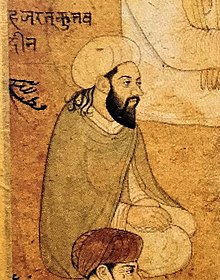
Back কুতুবউদ্দিন বখতিয়ার কাকী Bengali/Bangla قطبالدین بختیار کاکی Persian क़ुतुबुद्दीन बख़्तियार काकी Hindi クトゥブッディーン・バフティヤール・カーキー Japanese ഖുത്ബുദ്ദീൻ ബക്തിയാർ കാകി Malayalam ਕੁਤੁਬ ਉੱਦੀਨ ਬਖ਼ਤਿਆਰ ਕਾਕੀ Punjabi قطب الدین بختیار کاکی PNB قطب الدين بختيار ڪاڪي Sindhi Қутбуддин Бахтиёри Кокӣ Tajik Кутбуддін Бакхтіар Какі Ukrainian
Qutb al-Din Bakhtiyar Kaki | |
|---|---|
 Detail of Khawaja Qutub-ud-din from a Guler painting showing an imaginary meeting of Sufi saints | |
| Title | Khwaja |
| Personal | |
| Born | 1173 |
| Died | 1 December 1235 (aged 61–62) |
| Resting place | Mehrauli, Delhi 28°31′09″N 77°10′47″E / 28.519303°N 77.179856°E |
| Religion | Islam |
| Denomination | Sunni |
| School | Sufism |
| Lineage | Chishti Order |
| Jurisprudence | Hanafi |
| Creed | Maturidi |
| Other names | Malik al-Mashaa'ikh |
| Organization | |
| Order | Chisti Sufism |
| Muslim leader | |
| Based in | Delhi |
| Period in office | Early 13th century |
| Predecessor | Mu'in al-Din Chishti |
| Successor | Fariduddin Ganjshakar, Bu Ali Shah Qalandar |
Quṭb al-Aqṭāb Khwāja Sayyid Muḥammad Bakhtiyār al-Ḥusaynī, Quṭb al-Dīn Bakhtiyār Kākī (born 1173 – died 1235) was a Sunni Muslim Sufi mystic, saint and scholar of the Chishti Order from Delhi, India. He was the disciple and the spiritual successor of Mu'in al-Din Chishti as head of the Chishti order. Before him the Chishti order in India was confined to Ajmer and Nagaur. He played a major role in establishing the order securely in Delhi.[1] His dargah located adjacent to Zafar Mahal in Mehrauli, and the oldest dargah in Delhi, is also the venue of his annual Urs festivities. The Urs was held in high regard by many rulers of Delhi like Iltutmish who built a nearby stepwell, Gandhak ki Baoli for him, Sher Shah Suri who built a grand gateway, Bahadur Shah I who built the Moti Masjid mosque nearby and Farrukhsiyar who added a marble screen and a mosque.[2]
His most famous disciple and spiritual successor was Fariduddin Ganjshakar, who in turn became the spiritual master of Delhi's noted Sufi saint, Nizamuddin Auliya, who himself was the spiritual master of Amir Khusrau and Nasiruddin Chiragh Dehlavi.
Qutb al-Din Bakhtiyar Kaki had much influence on Sufism in India. As he continued and developed the traditional ideas of universal brotherhood and charity within the Chisti order, a new dimension of Islam started opening up in India which had hitherto not been present. He forms an important part of the Sufi movement which attracted many people to Islam in India in the thirteenth and fourteenth centuries. People of every religion like Hindus, Christians, Sikhs, etc. visiting his Dargah every week.
- ^ Biographical encyclopaedia of Sufis By N. Hanif.Pg 321
- ^ Smith, Ronald Vivian (2005). The Delhi that no-one knows. Orient Blackswan. pp. 11–12. ISBN 81-8028-020-9.
© MMXXIII Rich X Search. We shall prevail. All rights reserved. Rich X Search